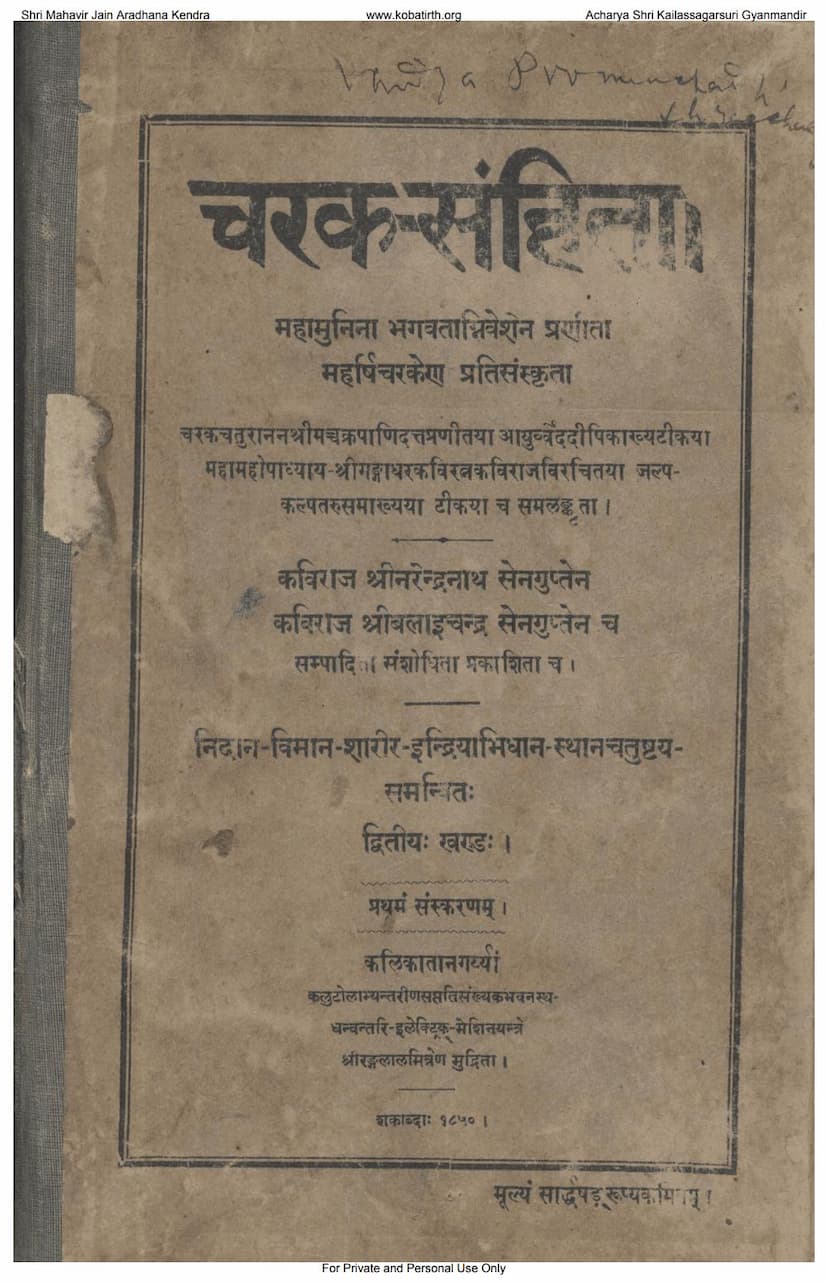Charak Samhita Part 02
Added to library: September 1, 2025

Summary
The provided text is the "Nidana Sthana" (Chapter on Etiology) of the Charaka Samhita, an ancient Indian Ayurvedic text. It details the causes, symptoms, and classification of various diseases, with a significant portion dedicated to fever (Jvara) and other ailments. The text is presented in Sanskrit with commentaries in Sanskrit by Chakrapani Datta and Gangadhara Kaviratna.
Here's a breakdown of the content based on the provided pages, focusing on the structure and major topics covered in the "Nidana Sthana" as indicated by the table of contents (Suchipatra):
Overall Structure and Commentary:
- Title: Charak Samhita, Part 02.
- Author(s): Muni Charak (original), Narendranath Sengupte, Balaichandra Sengupte (editors/publishers).
- Publisher: Ranglal Mitra.
- Commentaries: The text is elaborated with two prominent commentaries:
- Ayurveda Deepika (आयुर्वेदा दीपिका) by Chakrapani Datta (चरकचतुरानन श्रीमच्चक्रपाणिदत्त).
- Jalpa Kalpataru (जल्पकल्पतरु) by Mahamahopadhyay Gangadhara Kaviratna (महामहोपाध्याय श्रीगङ्गाधरकविरत्न).
Key Sections (Sthanas) covered in Part 02 (as per the table of contents):
The table of contents (Suchipatra) indicates that this volume covers four major sections:
- Nidana Sthana (निदानस्थान): This is the primary focus of the provided text, detailing the causes and diagnosis of diseases.
- Vimana Sthana (विमानस्थान): This section deals with the principles of measurement, classification, and etiology of diseases, often discussing concepts like "mana" (measurement) in relation to disease.
- Sharira Sthana (शारीरस्थान): This section likely covers the anatomy and physiology of the human body.
- Indriya Sthana (इन्द्रियस्थान): This section probably focuses on the sensory organs, their functions, and related pathologies.
Summary of Key Topics within Nidana Sthana (Based on Chapter Titles):
The provided table of contents for the Nidana Sthana (Pages 4-15) lists the following chapters (Adhyayas) and their subjects:
- Chapter 1: Jvara Nidana (ज्वरनिदान): This chapter focuses on the etiology and diagnosis of fever, a primary disease in Ayurveda.
- Chapter 2: Raktapitta Nidana (रक्तपित्तनिदान): Deals with the causes and diagnosis of Raktapitta (bleeding from various orifices, often associated with blood vitiation and bile imbalance).
- Chapter 3: Gulma Nidana (गुल्मनिव्दान): Focuses on Gulma, which refers to abdominal tumors or masses, their causes, and diagnosis.
- Chapter 4: Prameha Nidana (प्रमेहनिदान): Covers Prameha, a broad category of metabolic disorders including diabetes and urinary issues, detailing their causes and diagnosis.
- Chapter 5: Kushtha Nidana (कुष्ठनिदान): Deals with Kushtha, or skin diseases, including their etiology and diagnosis.
- Chapter 6: Shosha Nidana (शोषनिदान): Focuses on Shosha, which refers to wasting diseases, including consumption and emaciation, and their causes.
- Chapter 7: Unmada Nidana (उन्मादनिदान): Covers Unmada, or insanity and mental disorders, their etiology, and diagnosis.
- Chapter 8: Apasmara Nidana (अपस्मारनिदान): Deals with Apasmara, or epilepsy and seizures, their causes, and diagnosis.
Summary of Key Topics within Vimana Sthana (Based on Chapter Titles):
The provided table of contents for the Vimana Sthana (Pages 16-27) lists the following chapters and their subjects:
- Chapter 1: Rasa Vimana (रसविमान): Discusses the properties, qualities, and actions of tastes (rasas) and their impact on the body.
- Chapter 2: Trividha Kukshiya Vimana (त्रिविधकुक्षीय विमान): Focuses on the "three types of abdominal compartments" or the appropriate distribution of food within the stomach.
- Chapter 3: Janapadodhwamsaniya Vimana (जनपदोद्ध्वंसनीय विमान): Deals with the causes of epidemics or widespread diseases (Janapadodhwamsa), often related to environmental factors, social conditions, and collective actions.
- Chapter 4: Trividha Rogavisheshavijnaniya Vimana (त्रिविधरोगविशेषविज्ञानीयं विमान): Discusses the three methods of knowing diseases: by instruction (upadesha), by direct perception (pratyaksha), and by inference (anumana).
- Chapter 5: Srotasam Vimana (स्रोतसां विमान): Focuses on Srotas, which are channels or pathways in the body, their structure, function, and pathology.
- Chapter 6: Roganika Vimana (रोगानीकविमान): Deals with Roganika, which could refer to the classification or understanding of disease groups or armies of diseases.
- Chapter 7: Vyadhitavimana (व्याधितविमान): Likely discusses the constitution or presentation of diseased individuals.
- Chapter 8: Rogabhishagjitiya Vimana (रोगभिषगजितीय विमान): This chapter focuses on the knowledge and conduct of a physician (Bhishag) in relation to diseases, possibly discussing diagnostic methods, therapeutic considerations, and the physician's qualities.
Overall Theme:
The second part of the Charak Samhita, particularly the Nidana and Vimana Sthanas, is dedicated to a detailed understanding of disease from its origin to its manifestations. It emphasizes the importance of correctly diagnosing the cause (Nidana) and understanding the principles of measurement and classification (Vimana) to effectively treat diseases. The inclusion of extensive commentaries highlights the depth of knowledge and the interpretive traditions surrounding this foundational Ayurvedic text.
The text begins with "Athaato Jvara Nidanam Vyakhyasyamah" (Now, we shall explain the etiology of fever), setting the stage for a comprehensive exploration of diseases. It then proceeds to detail the causes and diagnostic signs of various conditions, underscoring the interconnectedness of factors like diet, lifestyle, season, and the physician's knowledge in the manifestation and management of illness. The Vimana Sthana extends this by analyzing diseases through different conceptual frameworks like "mana" (measurement) and the physician's understanding.
In summary, this volume of the Charak Samhita (Part 02) provides a deep dive into the causes, symptoms, and diagnostic principles of major diseases in Ayurveda, alongside foundational concepts of disease classification and measurement, all enriched by scholarly commentaries.